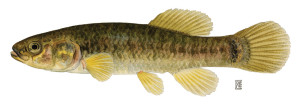
Here we are, mid-March and caught in the tension zone between winter and summer. The difference a few degrees of Earth’s attitude toward or away from the Sun makes is profound, and already trees are budding, lawns are greening, and our world is being repopulated by wildlife. Some species have just gone below ground to escape the cold and it’s consequences, and are now making their vertical migrations of just a few feet. Little springtails or snow fleas, abundant in forest soils, gather now in dry spots in great masses, a behavior I suspect has some reproductive component. Amphibians, frogs and salamanders, migrate to water to reproduce, and frogs will begin calling soon.
The amphibians give us reason to examine the water-filled swales in our preserve to try to gauge their populations. Not all salamanders reproduce by laying eggs in water, but here the most abundant species, the blue-spotted, does. One can sample them by setting cage traps to intercept them as they move in the water. The traps are placed carefully so that the animals can be collected and then released without harming them. In trying to sample salamanders, however, we also encounter other animals that are less known and which sometimes surprise us. Wood frogs are commonly caught and are expected. I don’t know how to estimate how many thousands there are in the forest, but they are abundant. This is probably a good thing, as amphibians are environmentally sensitive and their abundance may indicate a healthy ecosystem. It has also been interesting to catch crayfish- just a few Devil’s crayfish, a native species. They are able to survive in burrows the times when the swales dry up in summer and fall- apparently there is enough moisture below ground to keep their gills moist so that they can breathe.
There are three species of fish that we’ve also caught over the years despite the seasonal drying of the swales. Brook stickleback are small fish that inhabit streams in our area- tiny little fish a couple of inches long with a row of spines on their backs. They probably make their way into the swales in spring when the swales are full of water and flowing to the West Twin. Green sunfish, a panfish which can tolerate conditions of low oxygen, have also been found.
Perhaps the most interesting fish is the central mudminnow, a common species of warm, slow, murky waters. They are dark colored like the mucky bottoms they inhabit, and almost appear to be tadpoles. They are generally not solitary but seem to prefer to be with other fish, and they eat smaller fish and other creatures that they find on the bottom. They spawn in April, and burrow tail-first into the mud to hide. Most interesting is their ability to breathe air using modified swim bladders in their bodies like lungs. In winter they can find pockets of air beneath the ice to use when dissolved oxygen levels in the water become depeleted, and in summer can come to the surface if needed to breathe. Like the crayfish, they can burrow into moist mud when the swales dry up and survive by breathing air directly. Some of the wetland areas in our forest contain thousands of these little fish which go about their lives unseen to most of us. Both their presence and abundance must indicate their importance to our forest.
When you walk in a forest, you are surrounded by many living things, each with special abilities that allow them to survive. Some creatures are easily seen, but there are many more that go unseen. Whether we see or know of them does not affect their importance to nature- they are all important. Some just take a little more effort to be understood and appreciated.
